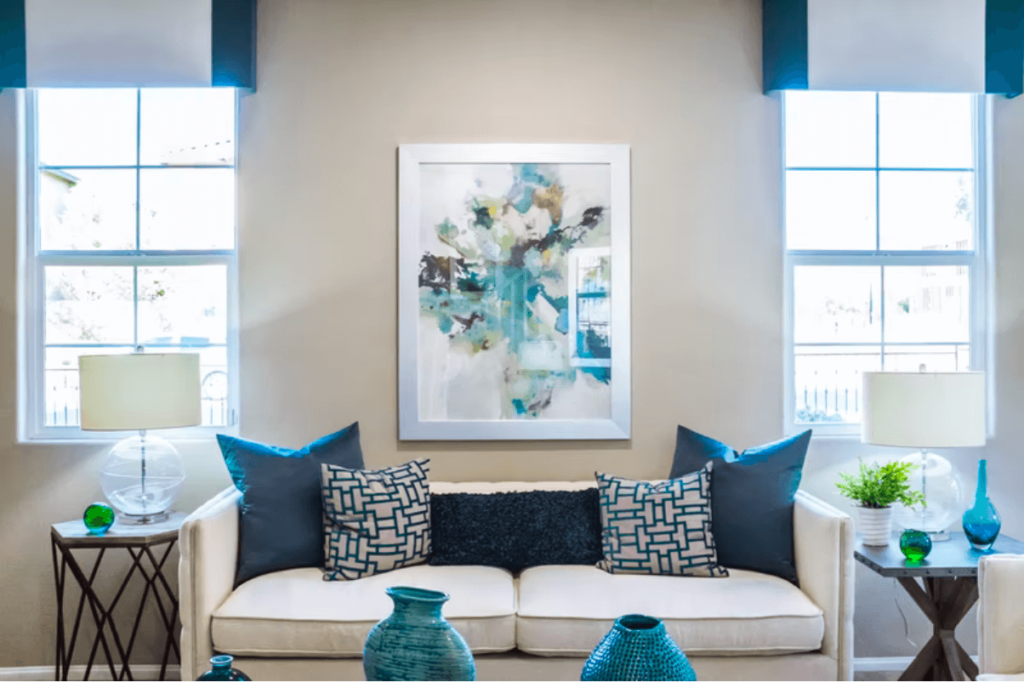When it comes to creating a beautiful home environment, one thing that you need to consider carefully is the color palette. Typically, two or three colors are all that you need. Anything more and you risk creating a messy, confusing, and headache-inducing environment.
However, how do you go about choosing the perfect color combination for your interiors? Read on to discover some ideas and suggestions that you can use to choose a striking and effective color combination for any interior design project.
1. Use color theory
There is only one place to begin when it comes to choosing the perfect color combination for your interior project, and this is with color theory.
What is color theory? Color theory is both the art and science of using color. It explains how we as human beings perceive color, and also the visual impact of how colors contrast, match, or mix with each other.
There are a number of guidelines and rules that interior designers use to communicate with people through the use of color, and that’s what color theory is all about.
It makes sense to start off by getting to grips with the color wheel. You can see a good example of this with Pantone interior colors below:
There are a number of different approaches you can use when basing your decisions on the color wheel:
-
- You can match colors, i.e. use two pairs that are next to one and the other on the wheel
- Clash colors with complementary shades, i.e. those that are opposite from one another, such as dark purple and bright yellow or red and green
- Split the contrast if it is too intense. This involves creating a ‘Y’ shape when using the color wheel.
- If you’re feeling brave, you may want to go double complementary, which involves creating an ‘X’ shape on the color wheel and choosing four colors. This can be quite a difficult one to master, as using more than three colors can be challenging. However, when you get it right, it can look beautiful.
- Keep things simple with a monochrome color palette. Rather than using different colors, simply use different shades of the same color to create a stunning impact.
The color wheel is a great go-to tool for anyone who is struggling to decide on a color scheme. Think about the sort of look you want to create when deciding what option to go for.
Do you want an interior color scheme that is subtle and calming? Or, would you prefer something bold and eye-catching? This will determine which of the five suggestions you use from above.
2. Find inspiration online for your color scheme
One of the easiest ways to choose a color combination is to look online for inspiration. There are lots of great online interior design magazines today, as well as exciting interior blogs. Plus, Instagram and Pinterest are renown for providing excellent interior inspiration!
Spend some time searching online so that you can find color combinations and interiors that you love. If you find a photograph of a room that you adore, you do not have to copy the image entirely. You can simply use it as inspiration for your home.
You can also base your choice of color scheme on items that you love. Again, spend some time looking online for key pieces that you are going to place in the room, whether this is a patterned fabric you love, an area rug, or a piece of artwork.
Once you have found something that you love, you will be able to use this to dictate the color scheme in the room in question. You can pull out specific shades, and you can use these colors to dictate the rest of your design choices in the room in question.

When doing this, it is vital to pay attention to the proportions of every shade so that you can make sure your color scheme i balanced.
There are some great interior design apps and tools today that give you the ability to try out different room designs, so you can get an understanding of what the room would look like if you choose a certain color as your overriding shade, and then use another color for room accessories.
3. Create mood boards to determine the color scheme that is right for you
Aside from the suggestions that we have mentioned so far, another good idea when it comes to creating the perfect color palette for your interior design project is to create a mood board.
Mood boards give you the chance to play around with different colors and styles so that you can get an understanding of what they all look like together before you go ahead and pay for furniture, fabrics, and such like.
There are lots of great tools out there that will enable you to create effective mood boards. Milanote is a good choice if you are looking for a tool that is easy to use and will enable you to organize all of your ideas effectively.
This software will run effectively on any modern website browser, providing as much space and levels of hierarchy as you may require for your creative interior projects.
From Sampleboard to Matboard, there are plenty of other tools available for you.
When you are putting together a mood board, it is not only important to think about the style of the room, but you need to consider the sort of atmosphere and feeling you wish to create.
After all, it is critical to remember that all colors have the ability to make us feel a certain way. They bring out emotions in us. Therefore, you need to think about how you want to feel in the room in question.
If you are designing a color palette for a bedroom, you may want to consider colors that are calming, soothing, and relaxing. If you are designing a home office, you may want to think about colors that are energizing and inspiring while giving you the ability to focus and be productive.
Therefore, it makes sense to consider how you want to feel in the room in question, and then once you have put together a mood board, you will be able to determine whether or not your choices will achieve what you have set out to achieve.
4. Consider how light impacts color
Last but not least, before you make your final decision regarding the color combination you are going to choose for your interior design project, you need to think about the impact that lighting will have.
Color is a reflection of light, so the amount and type of light within the room will have a considerable effect on your color scheme. It makes sense to experiment with how lights from recessed fixtures and lamps and natural light will impact color in furniture, paint, fabrics, and other surfaces.
Needless to say, daylight is deemed the ideal source of light because it has almost uniform intensity over the full visible spectrum of colors. Natural light changes from the moment the sunrises until it sets, as the rays from the sun travel through different amounts of atmosphere.
When you are thinking about a color combination for a specific room, spend some of your time in the space during the day and take note of how the changing light impacts it. For instance, a room that only has northern exposure is going to get less daylight when compared with other rooms on the property.
In this sort of room, a warm color palette makes the most sense, as it will help to soften the shadows, and it will react will to more hours of artificial light, which are going to be required in the room.
If the room in question is going to rely on a significant amount of artificial lighting, you need to consider the type of lighting that is used. Fluorescent lamps, for example, tend to create a cooler, blue light. However, incandescent lamps emit warmer and redder light than sunlight.
It is vital to keep this in mind because your choice of light is going to have an impact on how the colors appear within the room.
Final words on choosing the perfect color combination for your interior design project
As you can see, there is a lot that needs to be considered when it comes to choosing the perfect color combination for your home. We hope that the ideas and suggestions we have provided you with above will enable you to settle on the right color palette for your next interior project.



